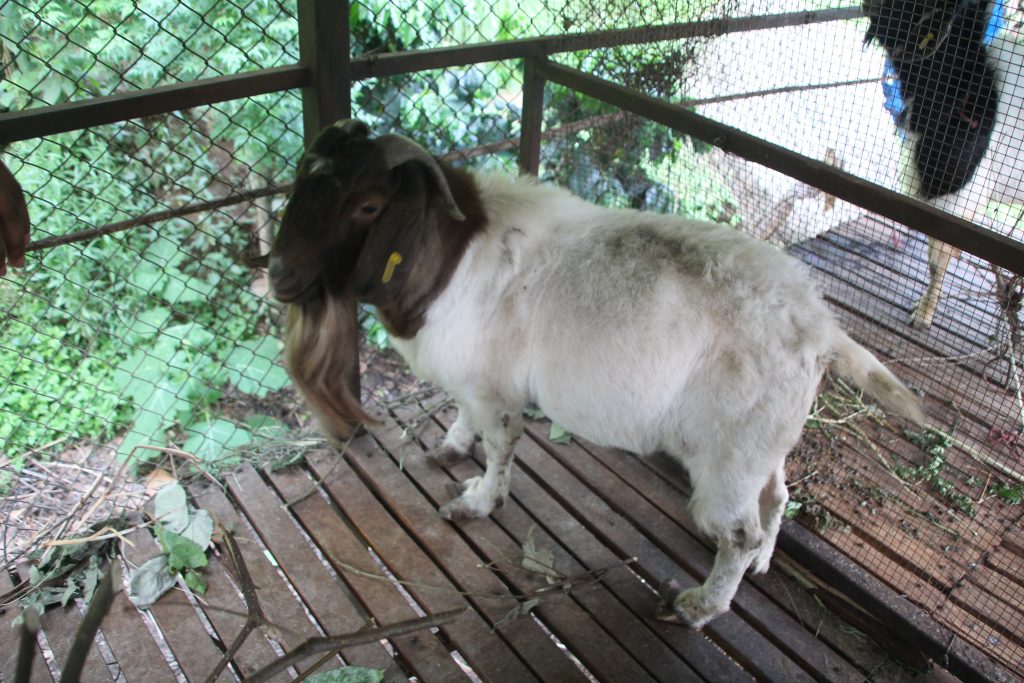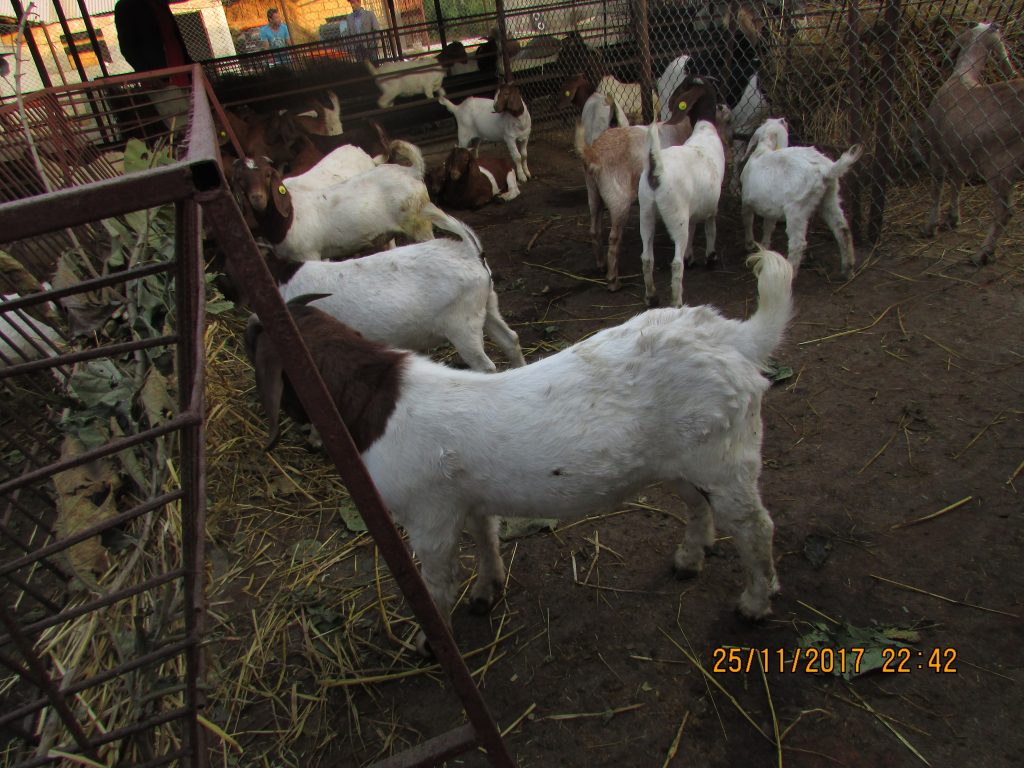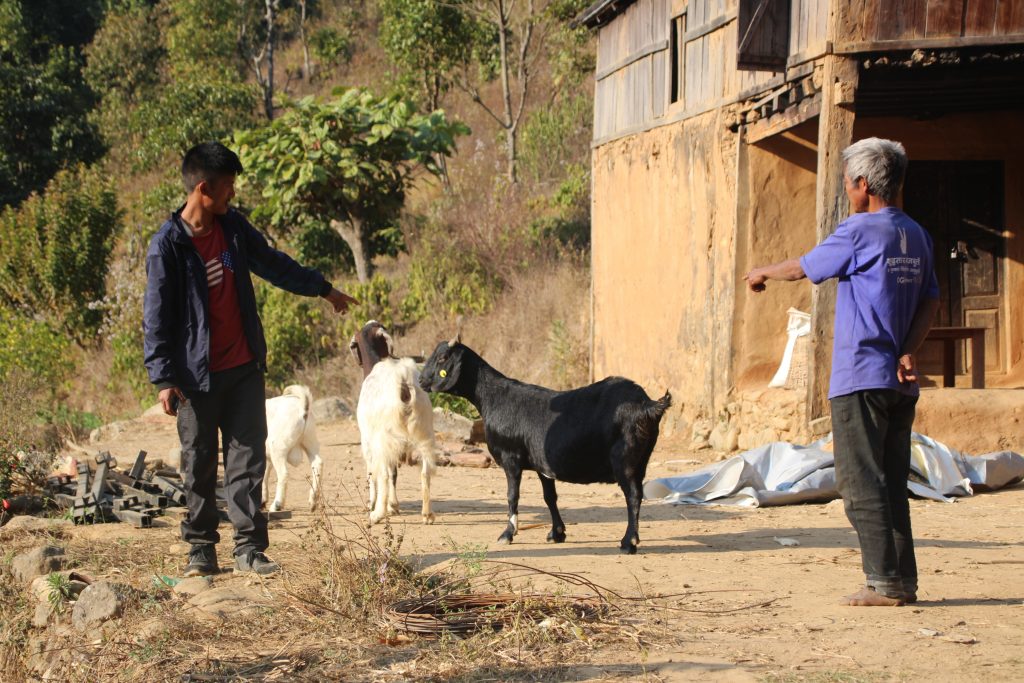SDA introduced the Boer Goat Breed in Kalikatar under one of its One Time Projects (OTP) in 2017/18.
The goats, an African breed, purchased from Chitwan were transferred to the Agricultural Land of SDA in Kalikatar after preparing the goat barn. The goat purchased from Chitwan was a Billy goat (he-goat) had a local breed of nanny goat (she-goat) bought from the local market as its mating partner.
Why did SDA introduce the Boer Goats as a One Time Project?
Like all OTPs, Boer Goat strengthens the existing SSLI activities in the respective project since it connects with the Agriculture project of SDA. All OTPs, on some levels, begin as an idea of intervention. Whether in agriculture, health or education, the organisation intervenes with full-fledged planning and strategies to address the issues in the communities within its capabilities.
SDA initiated the Boer Goat OTP for a lot of reasons. It is more financially viable than traditional goat farming. The local goats do not gain as much weight as the Boer goats, also known as meat goats. Also, the project area did not have adequate breeding support service, and the livestock practice was historically weak.
It became the first Boer goat farm in Kailash Rural Municipality. The organisation wanted to coordinate with farmers in ways that could uplift their economic standards, and the Boer goat farm checked the boxes for that purpose.

It was a new experience for SDA and the farmers in its project area. The farmers have to rear many local goats if they want to produce as much meat as they would get from fewer Boer goats. Also, the Boer goats sell for a much greater price than the local goats.
Hence, the provision of breeding local goats with a Boer goat ensures the birth of hybrid offspring that will grow into a larger size than local goat breeds. It means the farmers can benefit more from selling those hybrid goats.
The economically beneficial new breed of goats would encourage the farmers to continue livestock rearing with more energy. It is crucial to understand this particular approach of SDA in terms of the economic growth of the communities, among other things.
Project Background
According to the Nepal Livestock Traders Association (NLTA), on average, 400,000 goats are imported to Nepal annually. It means the supply of goat meat is less than its demand here. The silver lining of this crisis is that it creates an opportunity for profitable goat farming in Nepal.
Boer goats are very big-sized goats among the other popular meat goat breeds. Generally white-coloured with red or brown heads, Boer goats are fast-growing breeds with very high fertility rates compared to other goat breeds. Thus, most farmers prefer them for commercial goat farming purposes.
An adult male Boer goat weighs 110-135 kg, and an adult female Boer weighs 90-100 kg. Male Boer goats are for breeding and meat production, and females are for producing kids.
People in the communities have been rearing goats as livestock for ages now. So, with the knowledge of the locals and the capacity of Boer goats to produce more meat, the community economy will have a positive impact.
It’s not that the people have not been rearing goats on a commercial scale. It is just that rearing Boer goats commercially instead of local goats are a better income-generating option. If farmers who keep local goats shift to Boer goats, that could bring them more profits.
Since the Boer goats grow larger and faster than local goats, the farmers can take the Boer goats to the market sooner and sell them for good money. A good income source ensures access to sufficient and nutritious food.
The project essentially grasped the changes the farmers needed to make by informing them about Boer goat as a financially viable option.

Project Objectives
One of the foremost objectives was to promote the interest of the farmers in Boer goats. The long-term objective is that the people of Kailash Rural Municipality have Boer breed goats in their homes to produce meat and sell in the nearby markets.
The additional project objectives were to nourish and build network institutions in the municipalities, especially the farmer groups. Likewise, demonstration of hybrid breeding in SDA farmland and informing farmer groups about livestock and its benefits also were the intent of Boer goat OTP, along with improving and reinforcing the existing goat farm and goat farming system in the project area of the SDA was the purpose of the project.
The goal, in a nutshell, was to support farmers from a business point of view to improve household income and provide training for goat farming. It is a significant step that the SDA took to increase the economic condition of the families in the communities since even a young Boer goat sells for a heavy price.
Project Activities
The project team researched the availability, suitability and rearing of Boer goats in Nepal before introducing them to the communities.
Then, the team studied the differences between the local goat and the Boer goat before bringing the goat to Kalikatar. They made it aware that the Boer goats have higher productivity in meat production and fertility in the Chepang community.
The SDA Agriculture team researched and visited Boer breed goat farms and met with experts to discuss sustainability. Then, they prepared the place for goats in the SDA agricultural land, followed by purchasing and vaccinating the goats. Afterwards, the team distributed criteria and systems for goat multiplication and informed the farmers about the benefits of investment in goat farming.

After thorough research, the project team concluded that it made sense to have a male goat (though the initial plan was to purchase a female goat) so that the cross-breeding with local goats could multiply the breed sooner.
Upon the completion of the goat farm, the SDA Agricultural land became home to one male Boer goat and two local female goats. Soon after, the team started cross-breeding and distributed the new offspring to the villagers according to distribution guidelines after keeping one/two goats as a backup for SDA.
The SDA-Agriculture team cares for the goat consisting of one of the JTA-Veterinary (Junior Technical Assistant for Animals), who received support from SDA to study under the Education-Vocational project.
Distribution Criteria and System for the Goat Multiplication
The OTP team made a distribution system of goats to villagers and demonstrated hybrid breeding in the SDA Agricultural land. The team introduced a Sustainable Goat Reproduction Plan to support farmers with a business point of view to improve household income. The organisation eventually improved the Boer goat farming system with follow-up and investigations.
The agricultural team meets with the goat farmers to strengthen and build network institutions in the farmers’ groups every month. The farmers also receive care training, a check-up system, and knowledge for the multiplication of the goats. It takes five to six generations to breed a 100% Boer goat.

The Progress of the Project Thus Far
It was not an easy task to convince them to breed the local goats because the people there did not know about Boer goats before. But, slowly and steadily, through knowledge and demonstration, they came around. Hence, since the project launch, forty-one goats have been bred in the SDA farmland from wards three and four of Kailash Rural Municipality.
From the beginning, farmers have been visiting the SDA farmland to receive knowledge and training in breeding from SDA employees. Now, the farmers in the project area know the financial and otherwise benefits of rearing Boer goats. The members of the existing farmer groups and locals from the communities are skilled in breeding. It is because of the demonstration of hybrid breeding on the SDA farmland.
The SDA agriculture team meets with the goat farmer team to strengthen local management monthly. The breeding service centre supports the existing farmer groups in their locality. The farmers in the area can easily access the knowledge about Boer goats and multiply their learning with other people from the communities.
Farmers now have an option to breed their local goats and produce hybrid offspring. The breeding service is available to all the farmers because, as an organisation, it believes in the farmers of its project area. And it wants to capacitate them and provide a better option for commercialising livestock rearing.
Boer goat as a One Time Project develops a collective and cooperative system to encourage the mechanism of animal husbandry in its project area of Kailash Rural Municipality.

